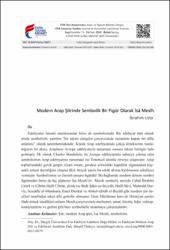| dc.contributor.author | Usta, İbrahim | |
| dc.date.accessioned | 2020-06-26T14:08:08Z | |
| dc.date.available | 2020-06-26T14:08:08Z | |
| dc.date.issued | 6-2020 | en_US |
| dc.identifier.citation | USTA, İbrahim. "Modern Arap Şiirinde Sembolik Bir Figür Olarak İsâ Mesîh." FSM İlmî Araştırmalar İnsan ve Toplum Bilimleri Dergisi, 15 (2020): 231-260. | en_US |
| dc.identifier.uri | https://dergipark.org.tr/tr/pub/fsmia/issue/55240/758071 | |
| dc.identifier.uri | https://hdl.handle.net/11352/3079 | |
| dc.description.abstract | Edebiyatın önemli akımlarından birisi de sembolizmdir. Bir edebiyat türü olarak
şiirde sembolizm, şairinin “bir takım simgeler çerçevesinde meramını kapalı bir dille
anlatımı” olarak tanımlanmaktadır. Klasik Arap edebiyatında çokça örneklerine rastladığımız
bu akım, Arapların Avrupa edebiyatıyla tanışması sonucu tekrar belirgin hale
gelmiştir. İlk olarak Charles Baudelarie ile Avrupa edebiyatında sahneye çıkmış olan
sembolizmin Arap edebiyatına yansıması ise Temmuzî akımla zirveye ulaşmıştır. Arap
toplumundaki gerek gergin siyasi ortam, gerekse şiirlerdeki kapalılık olgusundan kaynaklı
anlam derinliğine ulaşma fikri, birçok şairin bu edebi akıma katılmasına sebebiyet
vermiştir. Sembolizmin en önemli unsuru figürdür. Bu bağlamda modern dönem sembol
figürlerden birisi de hiç şüphesiz İsa Mesih’tir. Mesih sembolü, nesirde Cebrâ İbrahîm
Cebrâ ve Cibrân Halîl Cibrân, şiirde ise Bedr Şâkir es-Seyyâb, Halîl Hâvî, Mahmûd Dervîş,
İzzeddîn el-Munâsara, Emel Dunkul ve Abdulvehhâb el-Beyâtî gibi modern şiir öncüleri
tarafından sıkça dile getirilir olmuştur. Hem Müslüman hem de Hristiyan şairler
ifade etmek istedikleri anlamı Mesih çerçevesinde merhamet, umut, direniş, lider, ızdırap,
özdeşleştirme ve gurbet gibi bazı sembollerle anlatmaya çalışmışlardır. | en_US |
| dc.description.abstract | One of the important movements in literature is symbolism. As a literary movement,
it is defined as an allusive expression of the mind and spirit of the poet within the framework
of a number of symbols. This movement, which we find many examples in the
classical Arabic literature, has reappeared as a result of the introduction of Arabs to the
European literature. The reflection of symbolism, which first appeared in the European
literature with Charles Baudelarie, reached its peak with the Tammuzi movement in the
Arab literature. The idea of reaching the depth of meaning arising both from the tense political
environment in the Arab society and the phenomenon of allusiveness in poetry has
led many poets to participate in this literary movement. The most important element of
symbolism is the figure. Undoubtedy, one of the symbolic figures of the modern period in
this context is Jesus Christ. The symbol of Christ has been constantly mentioned by Jebra
Ibrahim Jebra and Jibran Khalil Jibran in prose, and by the pioneers of the modern poetry
such as Badr Shakir al-Sayyab, Khalil Hawi, Mahmoud Darvish, Izz ad-Din al-Musanara,
Amal Dunqul and Abdul Wahhab al-Bayati in poetry. Both Muslim and Christian poets
have tried to explain the meaning they want to express with some symbols such as mercy,
hope, resistance, leader, affliction, identification and expatriate within the framework of
Christ. | en_US |
| dc.language.iso | tur | en_US |
| dc.publisher | FSM Vakıf Üniversitesi | en_US |
| dc.rights | info:eu-repo/semantics/openAccess | en_US |
| dc.subject | Şiir | en_US |
| dc.subject | Modern Arap Şiiri | en_US |
| dc.subject | İsa Mesih | en_US |
| dc.subject | Sembolizm | en_US |
| dc.subject | Poetry | en_US |
| dc.subject | Modern Arabic Poetry | en_US |
| dc.subject | Jesus Christ | en_US |
| dc.subject | Symbolism | en_US |
| dc.title | Modern Arap Şiirinde Sembolik Bir Figür Olarak İsâ Mesîh | en_US |
| dc.title.alternative | Jesus Christ as a Symbolic Figure in Modern Arabic Poetry | en_US |
| dc.type | article | en_US |
| dc.contributor.department | FSM Vakıf Üniversitesi, FSM İlmî Araştırmalar İnsan ve Toplum Bilimleri Dergisi | en_US |
| dc.relation.publicationcategory | Makale - Ulusal Hakemli Dergi - Kurum Öğretim Elemanı | en_US |



















